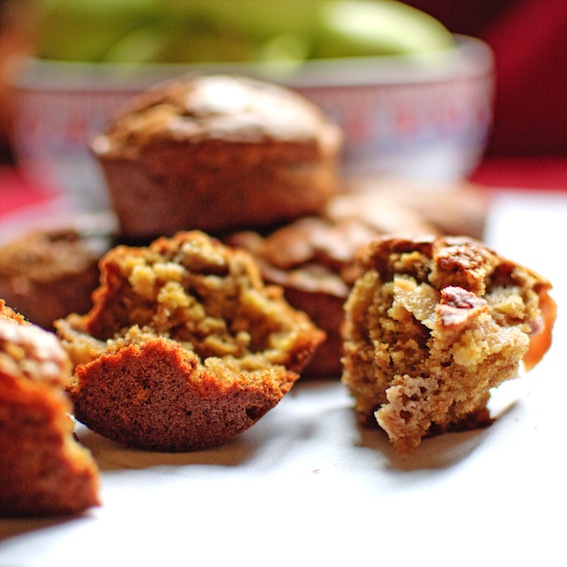-
Spice bread and watching a white hen unravel
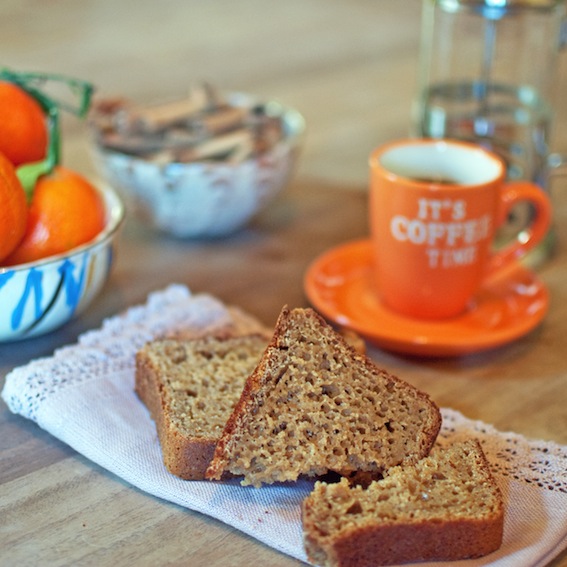
Have you ever seen a hen unravel? I hadn’t, but I have now. A friend (I use the term loosely in hindsight) gave us four hens last week. When I say hens, obviously I mean butch, feathered, street-wise ladettes hell-bent on stealing the others’ food, staying up all night and generally causing mayhen (sorry!). Our white ‘head’ hen was not amused by their arrival and ‘greeted’ them with firmly-closed wings. As soon as she caught sight of them, she strutted purposefully over to the kitchen, squawking loudly until I opened the window. When I explained that it was OK, they had been invited, she wandered off for a mad, muttering walk on her own in the woods, head between wings. Even now, a week later, she comes to check with me everyday that these ruffians are still welcome and spends more time than usual on her perch, disdainfully looking down at them.

This spice bread is deliciously soothing, which is useful when you’re trying to console a hen with a grievance.
Ingredients
500g raw honey
250g spelt flour
2 teaspoons active dry yeast
½ teaspoon cinnamon
½ teaspoon ginger
½ teaspoon nutmeg
½ teaspoon coriander
½ teaspoon cardammon seeds
Zest of 1 lemon
2 free-range eggs, beaten
100ml milk
Preheat the oven to 220°C. Dissolve the yeast in two tablespoons of lukewarm water and set aside. Gently warm the honey, spices and zest until very runny (about 3 minutes). Place the flour in a mixing bowl, leaving a well in the middle. Add the yeast and then the beaten eggs and milk to the well, followed by the honey and spice mixture. Beat until you obtain a smooth, liquid dough. Transfer to a 1kg greased loaf tin and cook for 1 hour 15 mins. Cover the tin with aluminium foil once it is golden brown. It is best to leave the bread in a tin to rest at room temperature for at least three days before eating. -
Raw honey and learning when to stop talking

We went to a local Christmas market this weekend and, while I was busy buying my own bodyweight in locally-produced Landaise honey, Léo was busy consuming his bodyweight in garbure (a duck and vegetable soup typical of Southwestern France). The quantities of food that Léo consumes and the enthusiasm with which he does so, are becoming acute sources of embarrassment to me — you would honestly think that he wasn’t fed at home. Sometimes, for example, we drop into a local café at about 11am for a cup of coffee and he orders a three-course ‘menu du jour’. I desperately feel the need to justify his appetite and end up woefully tying myself in knots with comments like: ‘I do feed him at home you know! In fact I feed him extremely well!’. On realising that this sounds horribly pretentious, I might add: ‘When I say extremely well, obviously I mean, you know, normally. Well not out-of-a-packet normally, but, errr, very healthily’. Of course I end up sounding like a furiously back-pedalling crazy person who should probably learn when to shut up.
Anyway, back to honey. Honey has been used for its healing properties since biblical times when it was used, amongst other things, to treat diphtheria. Physicians of ancient times, such as Aristotle, Hippocrates and Cornelius made reference to its healing qualities. A recent Russian study showed that beekeepers in Georgia who consumed raw honey and pollen on a regular basis frequently lived to over 100, a few even living as old as 150.
Raw honey is honey that has not been heated, pasteurised or processed in any way. It is alkaline-forming and contains a multitude of vitamins, minerals, amino acids, enzymes and powerful antioxidants as well as other natural nutrients. It also contains the enzyme amylase, which aids in the digestion of starch. A piece of toast spread with honey, for example, is more easily digestible than a piece of toast without as the enzymes in the honey ‘predigest’ the starch. (Beware of pasturised honey, which is more or less equivalent to refined sugar.)
Raw honey has anti-viral, anti-bacterial and anti-fungal properties. It promotes general health as well as digestive health and also strengthens the immune system. It helps to control allergies and is an excellent remedy for skin wounds and all types of infections. It can also stabilise blood pressure, balance sugar levels, relieve pain, calm nerves and has been used to treat ulcers. It is an expectorant and has anti-inflammatory properties which means that it is useful in the treatment of respiratory conditions such as bronchitis and asthma.
The different varieties of honey have varying properties as well as quite distinctive aromas. Here are a few:
Acacia, a light and clear honey, is one of the most popular and sweetest honey varieties because of its mild delicate floral taste. Due to its low sucrose content, it is a good choice for diabetics. Acacia cleanses the liver, regulates the intestine, and has an anti-inflammatory action on the respiratory system.
Buckwheat honey is a dark, full-bodied and rich in iron. It contains a higher percentage of antioxidants than other honeys and is perhaps the strongest and darkest of all varieties.
Heather honey is thick, amber in color and has one of the strongest and most pungent flavours. It is fragrant and floral with a very lingering aftertaste that is almost bitter. Prized since ancient times due to its medicinal properties, heather honey is extremely high in protein.
Linden honey is pale yellow in colour with a distinctive yet delicate fresh woody scent. Due to its sedative quality, it is effective in the treatment of insomnia and anxiety. It may also be used to treat colds, coughs and bronchitis.
Pine Tree honey is not overly sweet, has a strong aroma and is rich in minerals and proteins.
Thyme honey’s healing benefits are second to none. It is currently being used in hospitals in France for its infection-fighting, powerful antioxidant properties. A 2009 Greek study found thyme honey to reduce the viability of both endometrial and prostrate cancer cells..
Wildflower honey can vary in colour from very light to dark its flavour ranges from light and fruity to tangy and rich, depending on the mix from the different seasonal wildflowers.
Raw honey should not be given to children under a year old as they lack the stomach acid to de-activate any bacteria. -
Guest post: Patient, heal thyself (part 3)
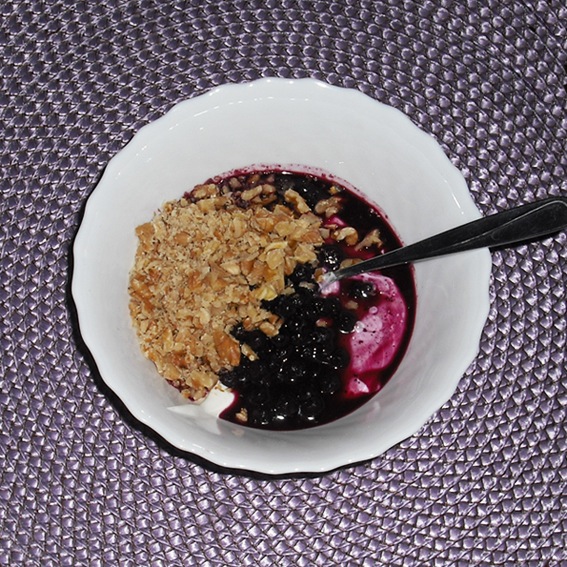
I had intended to continue sharing my recent benefits from switching in April to the ‘Eat Right 4 Your Blood Type’ plan, when last weekend put my intentions on hold. However, there was the added benefit of an experience important to all of us who need to watch what we eat, so I will share some of what occurred in this post.
While helping my partner erect an aluminum (aluminium, for those northwest of here) and plexi winter garden house, I suffered what appeared to be the beginnings of a heart attack. Germany has one very important aspect to their health care which I applaud: if the call is of a serious nature, an ambulance with a doctor on board is also dispatched to the scene. I won’t take you through the hooking up of a colourful assortment of tubes and such, and just say that after Mr. Toad’s Wild Ride through the German countryside, I arrived at a hospital with a highly-regarded cardio unit, where I spent several hours on monitors and bleeding into little glass tubes, on demand.
Upon determining that I was not in immediate danger, I was sent upstairs to a room, where they brought me the evening’s repast. Before continuing your digestion of this post, I suggest making certain that you are in a comfortable chair, as what I am about to share will stagger the imagination of most, and might even cause one to stagger in a literal sense. A caution has been made.
Dinner, for a person who has just arrived in the hospital’s cardio wing, and was under strict monitoring, was: two slices of bread, a slice of Emmentaler cheese (like Swiss cheese), three assorted slices of cold cuts, including salami, bologna and one that was unidentifiable, to me, and three tablespoons of watery yogurt. There were also two packets of mustard and a small cube of butter. No, I didn’t miss anything and I even looked under the tray, to be certain of this.
If you are a Type A person and you have already started the program, and know what the dos and don’ts are, you would recognize only the yogurt as being of any benefit, while the rest of the lot are absolute ‘don’ts.’ I mentioned this to the night nurse who remarked, ‘Everybody gets the same. No special treatment.’ Having passed two very elderly women in wheelchairs, as they were bringing me to my room, I wondered how they expected these two souls to be nurtured back to good health on such a meagre and very unhealthy diet.
Serving the least amount of food, with no regard to nutrition, is endemic in German hospitals and I have personally witnessed this in three other medical establishments. I have also asked physicians how they expect their patients to heal without proper nutrition, but they just shake their heads in a ‘it’s not my problem’ way. It is not a German attribute to rock the boat, so it is likely the insurance plan most patients are subscribed to determines costs for such things. It goes to prove the point that when bean-counters enter the picture, all compassion disappears. But, I digress.
Due to many issues, I had a sleepless night, one of which was being denied a sleeping pill, because, as the night nurse put it: ‘You are asking too late.’ Had I known my roommate could rattle the rafters with his snoring, I might have asked when I came to the room. But, unarmed with such important information, I was left without the necessary tool to overcome this obstacle and spent the night awake.
In the very early morning hours, nurses came to take blood and chose to poke a new hole in my other hand, although all previous blood samples had been taken from the hand with the nifty accoutrement that had been attached to me in the comfort of my best chair, the day before. Then, a young male nurse came to take my blood pressure, after which he presented a needle. When I asked what it was for, he told me it was to prevent thrombosis’ to which I replied: ‘No.’ I saw no need to have this additional toxin in my body, when I was still ambulatory and was not bedridden. He was perplexed, but he didn’t force the issue.
Later in the morning, one of the cardio doctors came to see me and spent some time telling me that I had not suffered a heart attack, stroke or anything severe enough to leave a telltale message in my system. The numbers they were giving me were the same as I had received from my cardio specialist, during my annual checkup in June, so I breathed a sigh of relief, and told her I wanted to go home. I was immediately counseled on the possible ‘consequences’ of such a decision, in view of their desire to keep me for observation and further tests, all of which I had experienced in June, and passed with flying colors. I then told her about my sleepless night, which seemed to go right past her, without reaction or comment.
The young doctor was adamant that I stay put, so I shared with her the details of my morning meal, which was: a slice of what looked like a mixed deli meat, two bread rolls, two packets of processed jelly, a cube of butter and three tablespoons of yogurt. I then continued with a description of the all important mid-day meal that had been brought to me, which was a vegetable consume, including remnants of carrots, potatoes and beans with a long, beef sausage placed in the middle of the bowl, a packet of mustard and two pieces of stale bread. After sharing these details with her, I told her about my eating plan and how it had cleared up two issues for me, which all of the ingredients the hospital had offered were sure to bring back to the fold. She shrugged in a kind of ‘what do you want me to do about it’ way, although I surmised that she was already thinking in her mind that there had to be some prescription that would do the trick rather well, in place of nutritious food.
When I asked her how she felt about serving the kind of food that was presented, to a person presumed to have a heart issue (after all, the did want to keep me for observation), she changed the topic back to the issue of ‘the possible consequences of going home.’
I thought about it and came to the realization that if I stayed there for the recommended period of time, taking the drugs they wanted me to ingest, in spite of showing no symptoms requiring drugs, and eating their food, I would have other serious issues returning to my life. I opted to leave, after telling her that I would much prefer to expire at home, eating healthy food, rather than in a hospital’s cold, dispassionate environment, while slowly being poisoned. She was not amused.
There were forms to fill out, more cautions expressed and then I was able to step outdoors, in the cool, dark afternoon, accompanied by my partner, who had brought one of our fun cars as a treat, in which to bring me home. The first breath of fresh air was rejuvenating and I continued to feel better during the ride home, in spite of my lack of sleep.
For that first meal upon my return to our home, I chose a breakfast meal of freshly chopped walnuts, Greek yogurt and blueberries. I also added a small dollop of maple syrup, which has been my sweetener of choice for more than thirty years. In the photo, you will see that I used frozen blueberries, as we are out of season for fresh, here, and I rather like having them year round. Frozen also allows me to vary the types of berries I use during the winter months, and allows me to thaw just what I need to avoid any spoilage, as well as providing a sugar-free juice from the thawing process.
I did see my GP this week and he reviewed the information about my adventure and came to the conclusion that, since this was a one-off event, that I should take it easy, lessen my work load some and give stressful situations a boot in the behind. I do have a tendency to work like I am still twenty-three, which is not to my benefit, now, and I had been overdoing it for a couple of weeks, even though I was experiencing a cold. My instinct tells me that it was just overloading the system with commitments and physical stress that caused my body to stop functioning at its optimum. When pressed for a reply, my GP begrudgingly admitted that leaving the hospital was a good idea, in this circumstance.
The point of sharing this experience is to demonstrate that in all cases, we will be responsible for our own health, even in an environment that is supposed to consider all aspects of our health its foremost concern. -
Healthy American-style pancakes and excess galore
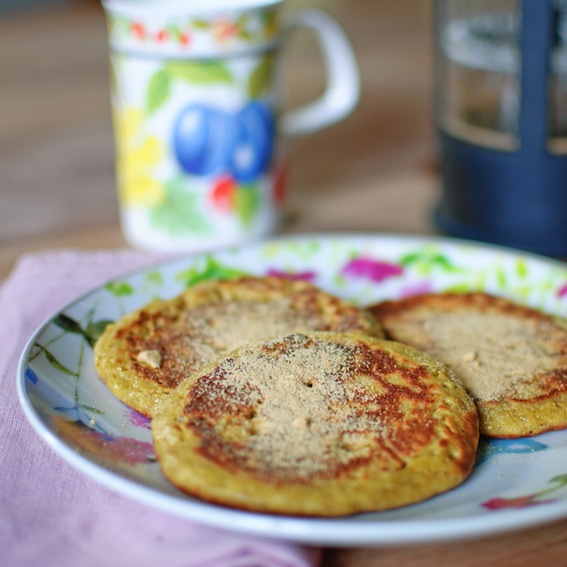
So far this year has been a year of extremes: the Spring saw more rainfall than we usually see in a whole year, we’ve had easily four times more tomatoes than usual, we have momentous courgette mountains, figs galore and at least 10 kilos of green beans. Black labrador madness doubled for much of the Summer as the neighbour’s puppy came to stay several times. But the prize for excess must go to Léo: on Friday night he broke not one but TWO wrists. He’ll be in plaster for six weeks which will be quite a challenge. Whether the challenge will be greater for me or for him remains to be seen (we had to confiscate his skateboard this morning!)…
These pancakes are full of goodness and perfect for cutting up and feeding to people with two broken wrists, which can come in very handy 😉 . Almonds are an excellent source of magnesium and whole milk is a great source of calcium, both of which are essential for, amongst other things, bone health.
Ingredients
65g ground almonds
70g spelt flour
1 tsp baking powder
½ teaspoon salt
1 large egg, beaten
130ml whole organic milk
Virgin coconut oil for frying
Combine the ground almonds, flour, baking powder and salt. Mix with the eggs adding the milk little by little until you obtain and smooth consistency. Heat the coconut oil in a frying pan and spoon about two tablespoons of mixture per pancake. Fry until golden-brown on both sides. -
Quatre-quarts (pound cake) and irritatingly untidy hens
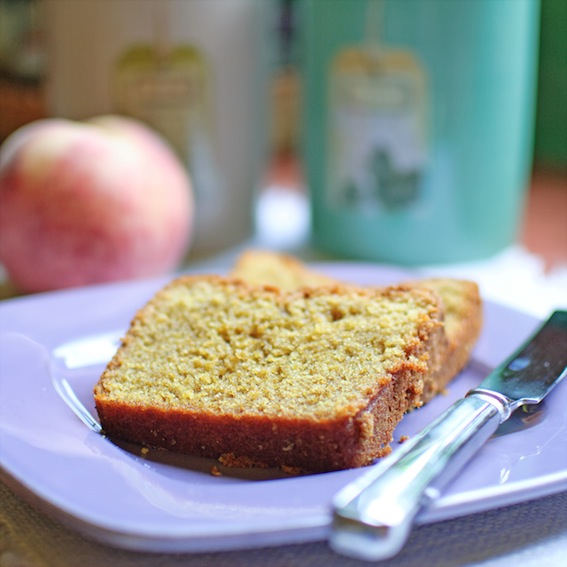
Things are dodgy here in the canine mental health department — Hugo’s OCD is back with a vengeance. He has decided that the three hens should be together AT ALL TIMES. Apparently stray hens are just too untidy to contemplate. Luckily, the white hen and older red one do seem to stick together (whether through choice or fear of Hugo is unclear). The younger red hen though is a bit of a rebel and seems to enjoy teasing neat-freak dogs. I’ve given up yelling at him for grabbing her by the wings and depositing her in her rightful place next to the others as he doesn’t seem to harm her (beyond making her soggy) and she’s obviously anything but traumatised. He makes the most of having her in his mouth to lick her clean; In Hugo’s world, cleanliness is next to godliness.
Although pound cake (quatre-quarts as it’s called in France) really contains too much sugar to be considered healthy, I’ve tried to make it as unhealthy as possible by using ‘whole’ ingredients. The result is rich, delicious and versatile: a great vehicle for all sorts of toppings or accompaniments.
Ingredients
250g spelt flour
2 teaspoons baking powder
1 teaspoon bicarbonate of soda
125g butter
125g extra virgin organic coconut oil
200g cane sugar
4 large organic eggs
2 teaspoons vanilla essence
1 tablespoon rum
Sift the flour, baking powder and bicarbonate of soda together and set aside. Cut the butter and coconut oil into cubes and leave to soften at room temperature for a few minutes. Beat with an electric mixer for about ten minutes until fluffy and then gradually add the sugar, continuing to beat. Add the eggs one at a time and whisk for another few minutes. Lastly, add the rum and vanilla essence and gently fold in the flour. Transfer the mixture to a buttered loaf tin and cook in a non-preheated oven at 160°C for an hour, or until a skewer comes out clean. Leave to cool in the tin. -
Apple and almond muffins and lawnmower paths
My husband has decided that the heat is too intense to navigate our land on foot and has starting going everywhere by lawnmower, as you do. He explained the logic at some length, although I don’t remember much; my mind must have slipped into neutral. I believe it was something to do with ‘efficiency’ and the fact that if I’m looking for him, I just have to follow the path of most freshly-cut grass. Or something. Our bank manager sounded more than a little bit nonplussed on the ‘phone this morning when I told him that he could indeed speak to ‘Monsieur’ just as soon as I had identified the most recently-cut grass strip…
These muffins are deliciously light and tasty whether you’re certifiable or not. They are adapted from one of my favourite cookbooks of the moment: ‘Love, Bake, Nourish’ by Amber Rose.
Ingredients (makes 12)
2 apples, peeled, cored and cut into pieces
1 teaspoon cinnamon
60g salted butter, softened
60g coconut oil, softened
150g spelt flour
2 organic eggs
1 teaspoon baking powder
160g agave syrup
60g ground almonds
50ml milk
Preheat the oven to 180°C. Sprinkle the apples with cinnamon and poach until soft in a small amount of water. Set aside. Cream the butter and coconut oil for about 4 minutes. Add a spoonful of flour, beat again, then add the eggs, beating further until the mixture is light and fluffy. Add a little more flour to prevent curdling. Gently fold in the rest of the flour, baking powder, agave syrup, ground almonds and milk. Lastly, fold the poached apples into the mix. Spoon the mixture into muffin trays and bake for 25 minutes.
-
Cheesy G8 muffins

The G8’s recent mufti extravaganza prompted me to create these American-style savoury muffins as a tribute to Obama, the only leader able to carry off the ‘my tie’s being laundered following a messy run-in with tomato ketchup’ look with any panache. I’m not altogether certain that the main objective of the summit was to evoke a Monty Python sketch, but that, to my considerable amusement, was the result.
Allison Pearson, writing in the Daily Telegraph, summed it up perfectly:‘Let’s be clear. You can wear a suit without a tie, on two conditions. One, the suit needs to be of the highest grade, woven from the chest-hairs of privately educated sheep. And two, you need to be Barack Obama. Otherwise, you end up with the deeply uncomfortable gallery of statesmen who were photographed at Enniskillen, as in a police line-up. David Cameron looked as if he had left his tie in the car; Vladimir Putin looked as if he had left his tightly knotted around the throat of a political opponent; the Japanese prime minister, unhindered by any tie, had had a rush of blood and opted for deck shoes as well, and may have to be dissuaded from wearing a ripped T-shirt and winklepickers next time. François Hollande, as usual, looked like a misplaced maître d’, who needed not just a tie but an apron and a white napkin over his arm to complete the look.’
These are adapted from a Hugh Fearnley-Whittingstall recipe.
Ingredients (makes 12 muffins)
250g German spelt flour
2 teaspoons baking powder
½ teaspoon bicarbonate of soda
Pinch of sea salt
1 teaspoon paprika
1 tablespoon Italian olive oil
2 organic eggs, beaten
80g butter, melted
200ml Russian kefir (or yoghurt)
75g strong English Cheddar, grated
75g French Comté, grated
75g courgettes, peeled and grated
1 teaspoon Worcestershire sauce
1 small onion, peeled and chopped into small pieces
Preheat the oven to 200°C. Fry the onions in olive oil over a gentle heat until golden. In a large bowl, sift together the flour, baking powder, bicarbonate of soda, salt and paprika. In another bowl combine the eggs, butter, kefir and Worcestershire Sauce and stir into the flour mixture until just combined. Last, fold in the onions, courgettes and cheese. Spoon the mixture into a muffin tin (greased if you’re not using a silicon mould) and bake for 18 minutes. -
Spelt kuglof and strange dog diets

My husband ceremoniously whipped up and presented Hugo with an an egg-white omelette yesterday. What was that all about do you think? I mean, just how bizarre is it to make an egg-white omelette for a big black labrador? As if the poor mutt doesn’t have enough issues to last a lifetime. Anyway, in a fit of rebellion I poured cream over his kibbles last night (Hugo’s, not my husband’s); he needs to learn to live a bit.
Kuglof (kouglof, kougelhof, kugelhof, kugelopf, kugelhopf or kouglouf) is typically found in Alsace, Germany, Switzerland and Austria. Traditionally it is baked in an earthenware mould with a central funnel, although there are now silicon or aluminium moulds available.
Ingredients
75g raisins
4 tablespoons rum or kirsch
15g bakers yeast
200ml lukewarm milk
500g spelt flour (or plain if you prefer)
1 teaspoon sea salt
75g cane sugar
2 eggs, beaten
75g butter, softened
75g coconut oil, softened (or just use 150g butter)
20g almond flakes
1 tablespoon icing sugar to decorate
Place the raisins in a small bowl and cover with kirsch or rum. Set aside to soak. Mix the yeast with 100ml milk and a tiny bit of flour and leave to double in volume. Mix the remaining flour, salt, sugar, eggs and milk. Beat or knead for about 15 minutes. Add the butter and coconut oil, mixing well. Next add the yeast and knead or beat until the dough becomes detached from the bowl. Cover with a damp tea towel and leave the rise for an hour in warm place (between 25-30°C). Reduce the dough to original volume by gently tapping. Add the soaked raisins and mix. Butter the mould and evenly distribute the flaked almonds in the bottom. Add the dough and leave to rise until it reaches the edge of the mould. Cook for 45 minutes in an oven preheated to 200°C. Once cooked, remove from the mould and decorate with icing sugar. -
Spelt brioche and a water-locked house
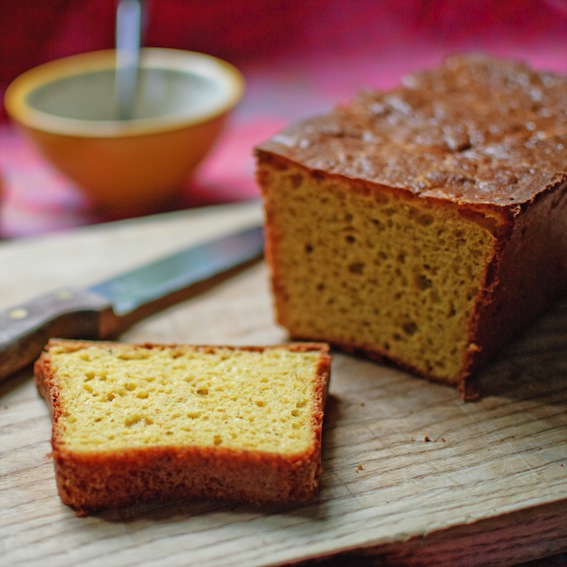
We had almost as much rainfall overnight as we usually have during May and June combined. Here it doesn’t rain, but it pours; the house was surrounded by an impressive moat this morning that I don’t recall being there when we signed on the dotted line. We now also boast a second river, which sounds fine in theory, but is not so practical in reality as we’re not very well-equipped boat-wise. Hugo took one look outside this morning and went back to bed, sighing heavily, the hens are developing webbed feet and learning to swim and I was out early drying off the horses with my hairdryer. All-in-all an appropriate morning for brioche.
Ingredients
300g spelt flour (or plain flour if you prefer)
100g butter, melted
100g coconut oil, melted (you can substitute this for a further 100g of butter)
1 teaspoon sea salt
1½ teaspoons dry bakers’ yeast
2 tablespoons cold water
4 eggs, beaten
40g cane sugar
Dilute the dry yeast in 2 tablespoons’ luke-warm water and set aside for 10 minutes. Mix the flour, yeast, salt, sugar, beaten eggs, melted butter and oil. Either knead by hand or beat in a mixer (better if you’re lazy). The dough must stay elastic in consistency so add a drop more water, if necessary. Leave the dough to rise in the mixing bowl for about an hour at a temperature of between 25-30°C (it should double in volume). Beat and knead the dough and leave to rise for a further hour. Beat and knead again and put the dough in the loaf tin. Leave to rise one last time. Preheat the oven to 200°C and cook for 25 minutes.
